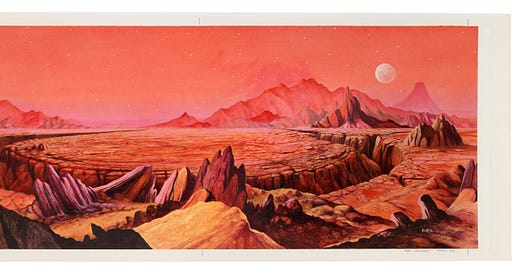
“Specialisation is an odious word.” If the eminent John Carter, an authority on all things bibliographical, really thought this, he had a strange way of showing it.
He edited, for one thing, a book of essays New Paths in Book-Collecting (1934), a highly useful waystation in the history of its subject. The specialisms under consideration in this volume include detective fiction, yellowbacks and books about the First World War; collecting in these areas was seen then, it seems, to be unusual.
And mercifully inexpensive, I’m guessing. David A. Randall, in his contribution to New Paths on modern American first editions, reckons that even Ernest Hemingway’s earliest books (“both published about ten years ago in small editions”) could be had for about $100 each.
Perhaps it would not have surprised the distinguished contributors to Carter’s essay collection to learn that someone else, around the same time, was wholeheartedly specializing in the much-derided genres of science fiction and fantasy. J. Lloyd Eaton (1902–68) was a Californian pulmonologist who started out collecting books when he was still in high school. Eventually, Eaton brought together some 7,500 hardback editions of works of science fiction, fantasy and horror, mostly dating from the late nineteenth century through to the 1950s. After his death, his collection was acquired by the University of California, Riverside, and it has only continued to grow since then: the Eaton Collection apparently now stands at 300,000 items and counting, including pulp magazines, fanzines, manga and ephemera.
So yes (in case anyone asked): the idea of collecting science fiction and fantasy has been around for a while. In fact, you could say that it’s been around for longer than the genre itself. “Science fiction is of that rare class of things which have been collected for longer than the category has existed”, Henry Wessells wrote in the Book Collector a few years back: “You have a literature that can claim Utopia (1516), Gulliver’s Travels (1726), Frankenstein (1818), the early writings of H. G. Wells or Jules Verne as founding texts . . . in addition to a century of work explicitly identifiable as science fiction”.
Apparently, it’s become relatively easy, even for those with no interest in delving into those precious historical depths, to build a decent collection in sf or fantasy. Supply and demand have done what they usually do to prices, but it seems to have taken an awfully long time for market values in sf and fantasy to change. The enterprising book-dealer Bertram Rota, just over twenty years Eaton’s junior, could testify in 1960 that first editions of Wells’s work were still to had for “less than a pound” – and “even the scarce titles cost only a few pounds”. More than two decades on, Joseph Connolly reckoned, in Modern First Editions: Their value to collectors (1984), that “only the absolutely dedicated are in pursuit of a complete [Ray] Bradbury collection”, while Slaughterhouse-Five remained the highlight for Kurt Vonnegut fans.
If such claims were true once, it’s safe to say that the case is thoroughly altered now. Wessells, writing under the title “Collecting Science Fiction in the 21st Century”, can mention the first issues of Weird Tales (March 23) selling for more than $30,000 – and now here comes an online auction of Science Fiction and Fantasy, courtesy of Christie’s, that is said to be the first such sale to be held by one of the major, international auction houses . . .
Bidding for Science Fiction and Fantasy runs from November 28 to December 12; the lots include “books, objects and artworks” but also related artefacts such as a piece of Martian rock (estimate £25,000–35,000) and a robotic simulacrum of Albert Einstein’s head (£100,000–150,000). A bargain by comparison looks to be the twenty-eight volume Works of H. G. Wells (New York: Charles Scribner’s, 1924–27), signed by the author (£4,000–6,000).
Also at the lower end of the spectrum is Frank R. Paul’s vision of New York being destroyed by a “monstrous solar ray” (£3,000–5,000) – an illustration to a story called “Enslaved Brains” by “Eando Binder” (a pseudonym for the brothers Earl and Otto Binder), published in 1934 (across three issues of Wonder Stories), and fancifully set in the 1970s. Think pesky scientists, eugenics and human brains being kept going for nefarious purposes.
The highest estimate of £250,000–350,000, meanwhile, belongs to both the Dune Bible (the storyboard for Alejandro Jodorowsky’s unmade adaptation of Frank Herbert’s Dune) and an “exquisite first edition” of Frankenstein (London: Lackington, Hughes, Harding, Mavor, and Jones, 1818). The latter is in a contemporary binding and belonged at one time to Sir Gilbert East (1764–1828), who had been a student of Jane Austen’s father George. East’s father Sir William East (1738–1819) had been a friend and benefactor to Mary Wollstonecraft – who was, of course, the mother of Mary Shelley, the author of Frankenstein.
Delvers into the fantastical past could also be tempted to bid for a gorgeous copy of the delirious Hypnerotomachia Poliphili (Venice: Aldus Manutius, 1499), which has an estimate of £120,000–160,000. It bemuses me to think that – according to Christie’s – somebody out there might pay a similar sum for Thomas Taylor’s original artwork for Harry Potter and the Philosopher’s Stone. I know which I’d rather have with me on the long voyage to the Red Planet.

*
ICYMI: This report from the frontier of book-collecting begins and ends with Martian visions, separated by about seventy years. St Mary’s Books and Prints has a new website as of this month; use the code welcome2024 for a 20 per cent discount. Test your knowledge of/stomach for nineteenth-century oddities via this recent list from Stuart Bennett Rare Books. Anyone interested in LGBTQ+ history should take a look at these complementary catalogues from Fugitive Materials and Langdon Manor Books.






Lovely piece.
I sourced the cover art for Handheld Press's Strange Relics anthology of archaeological Weird by (in desperation) buying a copy of a 1948 Weird Tales on Ebay. Including shipping from California it cost me $20, and we had a pristine magazine print to scan for a high res cover, rather than a tiny 25kb image from the internet. The artist's estate, according to the eminent John Clute, is untraceable.